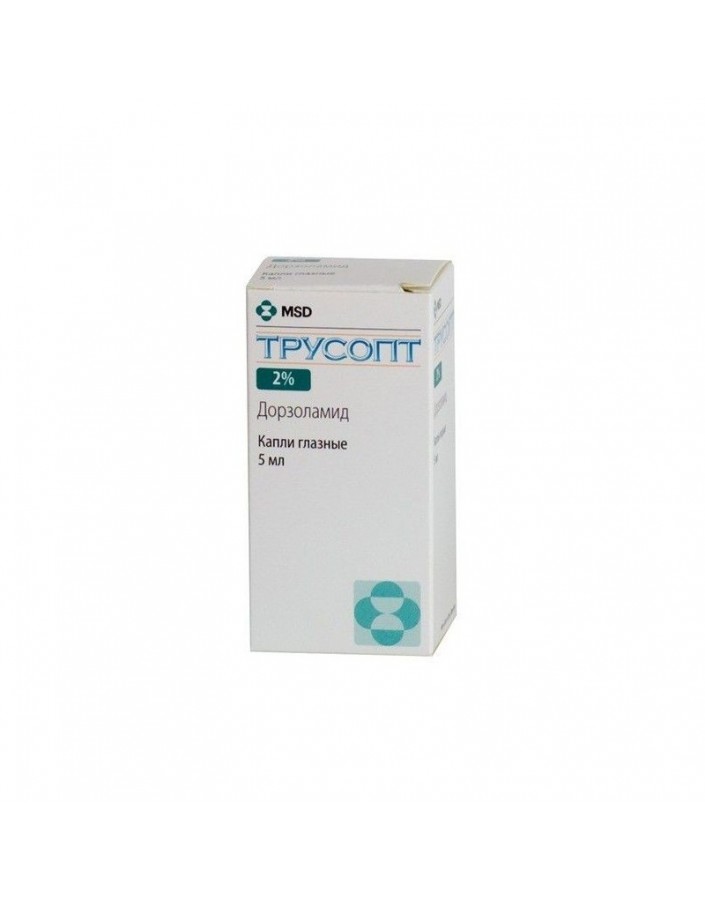




Security policy (edit with Customer reassurance module)

Delivery policy (edit with Customer reassurance module)

Return policy (edit with Customer reassurance module)
Eye drops
1 ml of eye drops 2% contains: dorzolamide hydrochloride 20 mg.
Excipients: hydroxyethyl cellulose, mannitol, sodium citrate (dihydrate), sodium hydroxide, water for injection. Benzalkonium chloride is added as a preservative.
Bottle of 5 ml.
Trusopt - carbonic anhydrase inhibitor for local ophthalmic use, which reduces intraocular pressure.
Trusopt is prescribed to reduce elevated intraocular pressure associated and not associated with glaucoma. Trusopt is indicated for patients:
- With intraocular hypertension (increased intraocular pressure).
- With primary open-angle glaucoma, including pseudo-excoliation glaucoma.
- With secondary glaucoma (without block the angle of the anterior chamber of the eye).
Truzopt can not be used for allergies to any of its components.
Pregnant women and women who are about to become pregnant should report this to the doctor. The doctor will decide on the appropriateness of using Trusopt.
Women who are nursing or are going to breastfeed should inform your doctor. The doctor will decide on the appointment of Trusopt.
The doctor determines the duration of the course of treatment and selects the right dose of the drug for each patient. You can not independently change the dose prescribed by the doctor. With an isolated application of Trusopta, the usual dosage is 1 drop to the affected eye (or both eyes) in the morning, in the afternoon and in the evening.
If to reduce intraocular pressure, the doctor prescribed Trusopt together with eye drops belonging to the group of beta-blockers, Trusopt's dosage is 1 drop to the affected eye (or both eyes) in the morning and evening.
With the simultaneous use of Trusopt with other eye drops, they should be instilled at intervals of at least 10 minutes.
To avoid infection, the tip of the vial should not touch the eye, tissues surrounding the eye, or any surfaces.
Ocular symptoms such as burning sensation, blurred vision, itching and pain in the eyes, tearing, redness of the eyes, irritation of the eyelids may occur. After instillation of the drug in the eye, the patient may feel a bitter taste in the mouth. Other side effects include headache, dry mouth, nausea, fatigue, dizziness, tingling sensation, the appearance of kidney stones and rarely allergic reactions such as rash, urticaria, itching, shortness of breath. Sometimes patients have other side effects of the drug, and some of them can be very serious. When prescribing a drug for therapeutic purposes, the following side effects were observed. If the following symptoms or any other unusual symptoms appear during Trusopt's administration, you should immediately inform your doctor.
Hypersensitivity: symptoms of local reaction, including eyelid reaction, and systemic reaction, including angioedema, bronchospasm, urticaria, and itching.
Nervous system: dizziness, paresthesia.
Organs of view: eye pain, redness, superficial punctate keratitis, transient myopia (disappearing after drug withdrawal), eyelid hyperkeratosis.
Skin and mucous membranes: contact dermatitis, throat irritation, dry mouth.
Use in patients who wear contact lenses: Patients who wear contact lenses should consult a physician before using Trusopt. Trusopt contains benzalkonium chloride preservative, which can be adsorbed by contact lenses. Before using the drug lenses must be removed, do not wear lenses earlier than 15 minutes after instillation of the drug.
Use in elderly patients: in the studies conducted, the effectiveness and safety of Trusopt were the same in elderly and young patients.
Use in patients with severe renal and hepatic insufficiency: Patients who have been diagnosed or previously had any liver or kidney disease should report this to the physician.
Influence on ability to operate the car and work with equipment: Some of the possible side effects of the Trusopt may impair the ability to drive and work with equipment.
The patient should inform the doctor about all medicines (including eye drops) that he uses or plans to use, including those that are sold without a prescription. You should pay particular attention to taking large doses of Aspirin.
In case of overdose (if a patient has dropped a lot of drops in the eye or accidentally drank the contents of the bottle), you should immediately consult a doctor.
The drug should be stored in a dark place at room temperature (15-30 ° C).